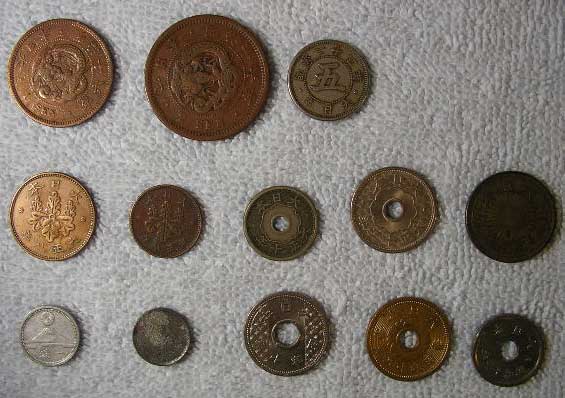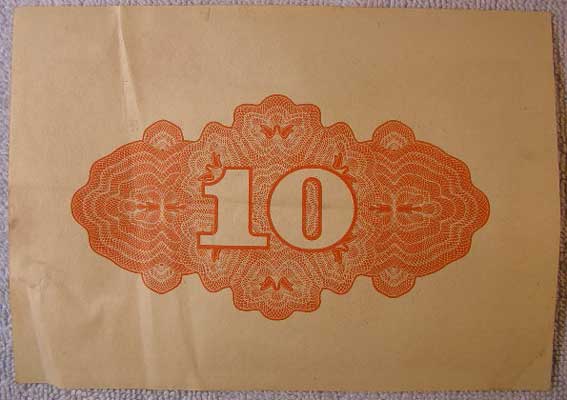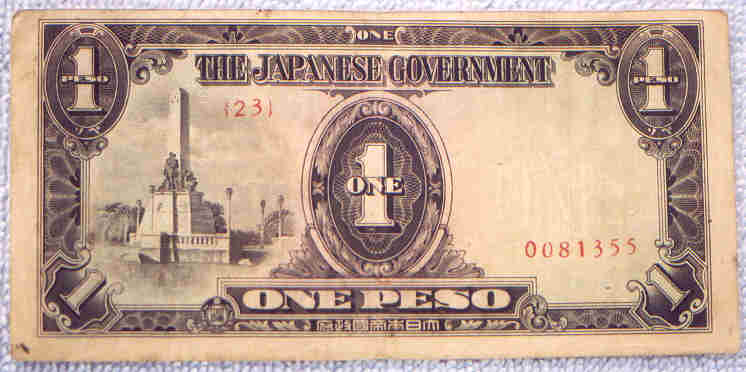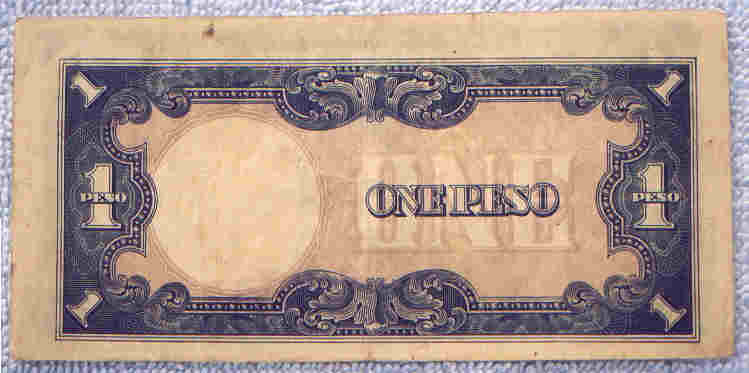Japanese
Currency, Coins, Bonds & Invasion Scrip
Japanese
troops had to get paid, and wherever the Japanese took over, they issued
invasion scrip for use in the local economy. Here are a some samples.
First,
here is some actual Japanese currency. I am certainly no expert in this field,
but from a book I picked up at the bank of

Here are the backs of the two notes.

Here are

Here are the backs of these notes.

Coins
Here are some coins from the period ending in
1945. One sen is 1/100 of a yen.
The top row has coins from the Meiji era (1868-1912).
From left to right, they are: one sen, Meiji 16 (1883); two sen, Meiji 16
(1883); five sen, Meiji 23 (1890).
The middle row has coins from the Taisho era
(1912-1926). From left to right: one sen, Taisho 8 (1919); five rin=1/2 sen,
Taisho 8 (1919); five sen, Taisho 10 (1921); ten sen, Taisho 12 (1923); fifty
sen, Taisho 12 (1923).
The bottom row has coins from the Showa era
(1926-1988). From left to right: one sen, Showa 17 (1942); one sen, Showa 19
(1944); ten sen, Showa 10 (1935); ten sen, Showa 15 (1940); ten sen, Showa 19
(1944).
Note how, for example, one sen went from being
a large copper coin to a small aluuminum or tin one (and worse was yet to come,
as you can see below!)

Here is the other side of the above coins in
the same order, showing the dates in most cases.

This is what one sen ended up as. It is
referred to as ceramic. The mountain is probably

Here is the other side. There is no date. Supposedly
these were prepared in 1945 but not issued (how some got out, I donft know). There
were also five and ten sen denominations in this material.

Bonds
This
is a discount war bond. It was sold for seven yen on June 22, 1942 and was to
be redeemed for ten yen on August 8, 1952 after

Mercifully, the back is more or less
self-explanatory. There is a watermark in the paper but I canft read it. The
bond is 181mm by 127mm (7 1/8h by 5h).

Invasion Scrip
When
the Japanese forces took control of an area, they issued their own invasion
scrip to replace the local currency. They often issued it in huge quantities,
rendering it worthless almost immediately. This was not helped by the
involvement of many Kempeitai
(military police) officers in large-scale counterfeiting, which was relatively
easy since the scrip generally did not have serial numbers, just Roman letters
to indicate the area and a gblockh of notes. The top note shown here is often
mistaken to be for a planned invasion of the

Here are the backs of the notes. Except for
colour, the back of the one dollar and the back of the one rupee are the same!

Here are the front and back of peso-denominated
invasion scrip used in the


Here is a five guilder invasion scrip note for
use in the occupied Dutch East Indies (now


If I find a good reference on the currency and scrip
I will add it here.
Last updated: September 25, 2004. All contents
are copyright Teri unless otherwise specified and may not be used elsewhere in
any form without prior permission.
Click here to go back to the Other Militaria
page: Nambu World:
Teri's Other Japanese Militaria Page
Click here to go back to the main page: Nambu World: Terifs WWII Japanese
Handgun Website